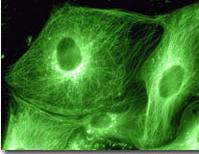
Problems for
Intermediate Methods in Theoretical PhysicsEdward F. Redish
 |
|
If the cell contains a gene for "green flourescent jellyfish protein," (GFP) a marker will be attached to the protein that will flouresce if the cell is illuminated with a particular wavelength of light. This marker is not immediately effective when the protein is created. The protein has to fold into a particular shape before it will flouresce. The newly created protein "brightens" at a rate b.
The mechanism destroying protein at a fixed rate does not care whether the protein is bright or not.
 | GFP attached to a protein used in the construction of microtubules by the cell, showing location of tubules. |
| University of Maryland | Physics Department | Physics 374 Home |
|---|---|---|
 |
 |
 |
Last revision 6. September, 2004.